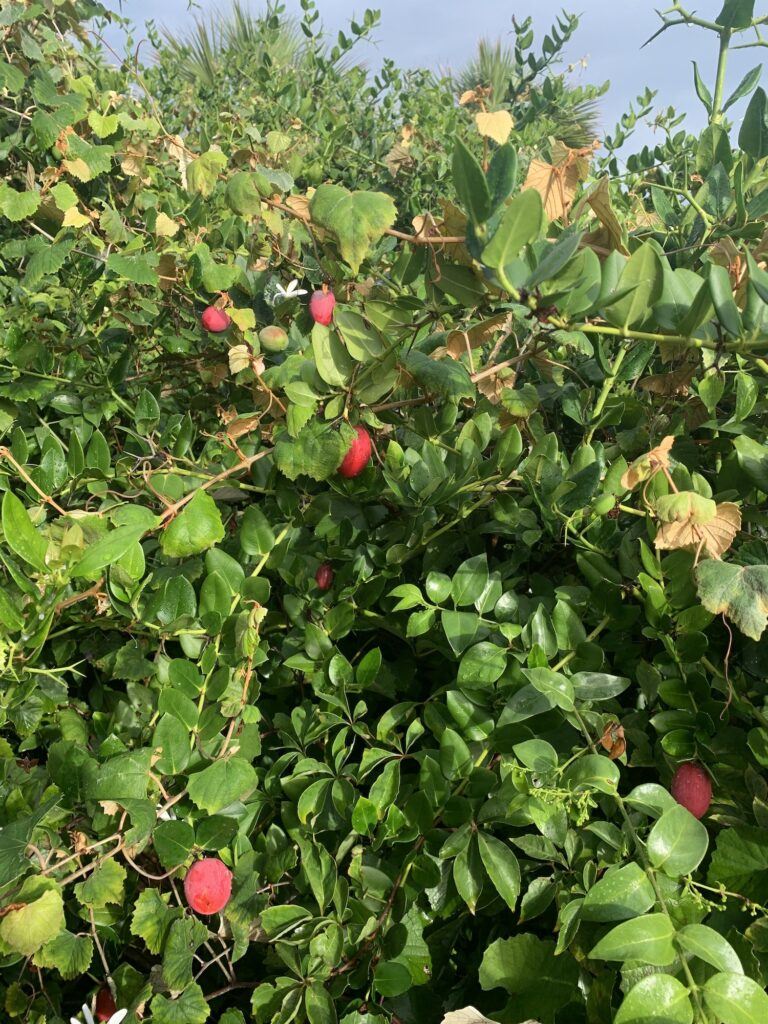
Carissa macrocarpa, a fruiting ornamental hedge, photo by Green Deane
Although it fruits all year, the Natal plum is busily ripening now. Salt, drought and wind tolerant the species is often used in coastal landscaping. You can find it from hurricane-strafed Miami Beach to the dry hills of San Diego. A commercial fruit elsewhere it’s never caught on in the United States despite the effort of several exotic fruit groups. Only the ripe fruit is edible. The rest of the plant is toxic. You can read more about it here.
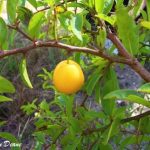
Eat tallow plums in moderation. Photo by Green Deane
Also fruiting well now is the Tallow plum, another native more appreciated in other countries as a commercial crop. A few hundred feet from where I live deer are raiding the Tallow Plums, it attracts does and fawns enough so moms will leave their fawns alone in the open to browse on the shrub. The fruit sweetens as it ripens from green to yellow. You can read more about it here.
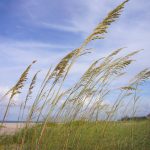
Edible Sea Oats are protected but their edible relative Wood Oats are not. Photo by Green Deane
Also reaching maturity is the protected sea oat. It is protected not because it is scarce but it is one of the species that helps to hold dunes in place, the same reason why the prolific sea grape is protected. One solution is to take sea oat seeds home and plant them so you can have your own far from beach dunes. Or you can look for them in the forest where they are called wood oats (a different species but they look and taste the same.) To use the wild oats as food they have to be thrashed, the seed beaten from the hull around it. The grain then can be boiled or ground into oat flour. It is lower in protein than cultivated oats.
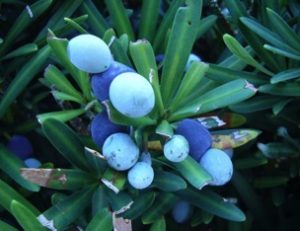
Podocarpus is setting. Photo by Green Deane
Starting to ripen are Podocarpus arils, in fact we found some last week in Sarasota. The Podocarpus is a very common hedge plant which if ignored will grow into a pine-sized tree. The seeds are mildly toxic (and on the end) but the ripe arils are very grape-like and can be used like grapes, eaten off the bush or made into jelly and wine et cetera. The seeds are listed as toxic but I know of an adult who ate two at one time and had no issue. That said, don’t eat the seeds. When the Podocarpus fruits ripen can be something of a guess. Locally I look for them in August but you can find them in June sometimes (or often soon after transplanted into landscape.) The fruit can last several weeks and are edible even when they begin to dry and resemble raisins. Oddly, in in downtown Winter Park, a few Podocarpus have escaped trimming and have grown into moderate-size trees. I have seen those fruit in December. You can read more about Podocarpus here.
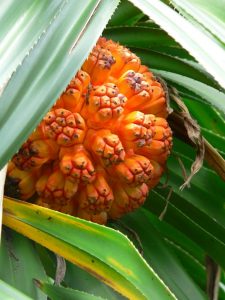
Ripe Pandanus is easy to spot.
The question every time you see one of these is which species is it? There are some 600 of them in the genus and several are edible one way or another. The one we see regularly in Dreher Park has a little bit of calcium oxalate in the fruit and sometimes doesn’t. So one has to taste it carefully. What you do is take a section, which is a cluster of smaller parts, and chew it. The goal is to get the juice out of it more than anything else though some pulp is edible. Last year this particular growth lightly burned my lips enough to notice but not bothersome. Three species are commonly known as edible: Pandamus amaryllifolius, which it probably was not, Pandanus fascicularis, a good possibility as is Pandanus tectorius. The latter is the most consumed of all and it would be a good find. One of the more interesting things about the Pandanus is how it burns when lit. A dried Pandanus stalk can smolder for days like a baseball bat-sized cigarette. It was how some of the Aboriginals of Australia carried fire from one place to another. Among other sighting in the park are Coco-plums and Simpson Stoppers both should be starting their seasonal run. The Sea-grapes are still green. They ripen around the first of September. Mahoes were not yet in blossom though we did find one last time there. They are unusual in that their blossom is yellow in the morning then turn red in the afternoon. Botanist tell us that is to attract different pollinators. The blossoms also have more antioxidants in the afternoon.

Foraging classes are held rain or shine, heat or cold. Photo by Nermina Krenata
Just one foraging class this weekend, trying to dodge tropical systems and 90-degree weather.
July 1st, Eagle Park Lake, 1800 Keene Road, Largo, FL 33771. Meet at the pavilion near the dog park. 9 a.m.
Bring cash on the day of class or click here to pay for your class
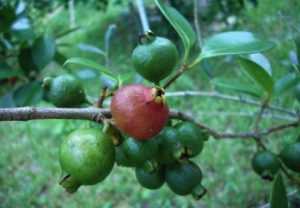
You want pink and green strawberry guava. Photo by Green Deane
Also just beginning to fruit is a species that is very invasive in some areas, Hawaii for example: The Strawberry Guava. I had one in my yard for about 15 years. Not only are the fruit edible but the dried leaves can be made into a passable tea that also has medicinal qualities. One does, however, need to know some about the species to make the most of the fruit. It’s a little smaller than a ping-pong ball, has tough seeds, and starts out green and hard. As it ripens and softens it will get shades of pink, yellow and red and eventually become dark red and soft, hence the name “Strawberry Guava.” The fruit is tart and sweet, more tart when young, more sweet when older. Despite the name I never tasted a strawberry flavor in any of the fruit. The problem is unless you spray the tree with insecticides the ripe fruit will be full of fly larvae (which you can also view as free protein.) When the fruit is just starting to turn from green to red the rind is too hard for the flies to lay eggs through. But by the time the skin is soft and ripe they are prime breeding ground. Thus you have a choice, slightly ripe and tart but bug free, or, very ripe and sweet and squirming. To read more about the Strawberry Guava go here.
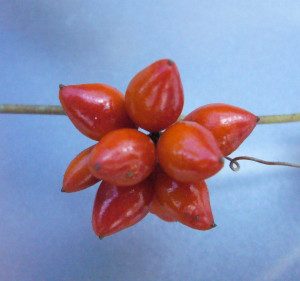
The red berries of Smilax walteri. Photo by Green Deane
Smilax has moved into its lesser time of year. Considered by many to be one of the best spring time greens the tips this time of year can be bitter and or peppery. Cooking moderates that. Interestingly Smilax is not a vine, at least not botanically. It is considered a climbing shrub. There are two groups with that classification in Florida, the Smilax and the Nickerbean. Apparently they have multiple trunks and grow about 12 feet long. This qualifies them as a shrub by some thinking. The ripe berries are marginally edible and I have not heard of any non-edible Smilax. That said I don’t eat red-berried Smilax because they are rather singular locally (and it has to have red berries for a reason even if I don’t know it.) I just don’t see Smilax walteri too often so I tend to let it be. There is a different red-berried Smilax species on Crete — S. aspera — and those berries are eaten. S. aspera also has male and female plants. To read more about Smilax go here.

Green Deane videos are now available on a USB.
150-video USB would be a good end of spring present and is now $99. My nine-DVD set of 135 videos has been phased out. The USB videos are the same videos I have on You Tube. Some people like to have their own copy. The USB videos have to be copied to your computer to play. If you want to order the USB go to the DVD/USB order button on the top right of this page. That will take you to an order form. I’d like to thank all of you who ordered the DVD set over the years which required me to burn over 5,000 DVDs individually.

Green Deane Forum
Want to identify a plant? Perhaps you’re looking for a foraging reference? You might have a UFO, an Unidentified Flowering Object, you want identified. On the Green Deane Forum we — including Green Deane and others from around the world — chat about foraging all year. And it’s not just about warm-weather plants or just North American flora. Many nations share common weeds so there’s a lot to talk. There’s also more than weeds. The reference section has information for foraging around the world. There are also articles on food preservation, and forgotten skills from making bows to fermenting food.
This is weekly newsletter #564. If you want to subscribe to this free newsletter you can find the sign-up form in the menu at the top of the page.
To donate to the Green Deane Newsletter click here.

